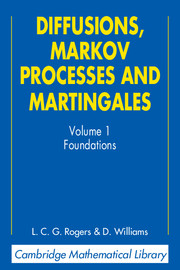From the Original (1979) Preface
Published online by Cambridge University Press: 05 February 2014
Summary
Long ago (or so it seems today), Chung wrote on page 196 of his book [1]: ‘One wonders if the present theory of stochastic processes is not still too difficult for applications.’ Advances in the theory since that time have been phenomenal, but these have been accompanied by an increase in the technical difficulty of the subject so bewildering as to give a quaint charm to Chung's use of the word ‘still’. Meyer writes in the preface to his definitive account of stochastic integral theory: ‘ …il faut … un cours de six mois sur les définitions. Que peut on y faire?’
I have thought up as intuitive a picture of the subject as I can, written it down at speed, and refused to be lured back by piety (or even by wit!) to cancel half a line. ‘First’ intuition, which is what you need when you are learning the subject, is raw, rough and ready; and, as you have guessed, I make the excuse that it demands a compatible style and lack of polish.
Note that I wrote ‘first intuition’. Consider an example. Meyer's concept of a right process is exactly right for Markov process theory, but the concept is the result of a long evolution. To understand it properly, you need a highly developed intuition, and that takes time to acquire. The difficulty with the best advanced literature is that its authors have too much intuition; never make the mistake of thinking otherwise.
- Type
- Chapter
- Information
- Diffusions, Markov Processes, and Martingales , pp. vii - viiiPublisher: Cambridge University PressPrint publication year: 2000



